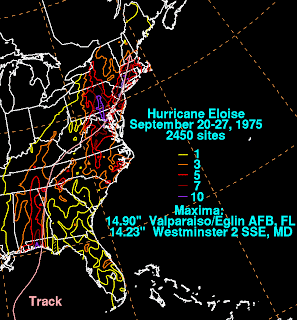Professor Storm's Note: This blog was written by Alexandra St. Pe, who recently received her meteorology degree and has joined Professor Halverson's research group, where she is studying hurricanes and severe storms.
After a wet and overcast week, the first day of fall (Friday, September 23, 2011) did not bring comfortable fall-like conditions, but rather heavy afternoon rainfall that initiated Flash Flood watches and warnings across the Mid-Atlantic. Interestingly enough these conditions are not caused by a powerful cyclone sweeping through the region, but rather a sluggish frontal boundary stalling just east of the Blue Ridge Mountains. In fact, the main weather system, an upper-level low, remains stalled over the Great Lakes. The vortex is keeping the Baltimore-Washington corridor under overcast conditions yet again. Below I will break down the factors that precluded Friday’s rain event, discuss the numerical weather model output for the event, then follow up with rainfall accumulations and climatological plots for Baltimore.
Synoptic Set-up:
Beginning overnight Thursday, a deep southerly wind flow ushered in a tropical plume type air mass. This flow strengthened as the pressure gradient tightened between the deepening upper-level low over the Great Lakes and a building ridge of high pressure over the West Atlantic.
This upper-level feature was coupled within a jet streak (a pocket of localized fast wind embedded within the jet stream), which produced widespread rising air, setting us up for a widespread rain event.
The jet streak is shown by the light blue and turquoise colors in the upper-level analysis below. This pocket of fast winds was moving around the eastern side of the stationary upper-level vortex parked over the Great Lakes.
The Friday early morning analysis (8 EDT) shows a surface trough (dashed yellow line), ahead of a stationary front to the west, stretching from the southern Appalachians northeastward as far north as Massachusetts. With strong southwesterly flow (blue wind barbs) and a moist atmosphere on hand, the frontal boundary enhanced the uplift of air in a north-south ribbon oriented over the Mid Atlantic. The area of precipitation filled in along this boundary throughout the morning as it lifted northward.
Friday morning (8am EDT) atmospheric weather balloon data indicated that the atmosphere was primed for a heavy downpour as the air remained saturated (indicated by red temperature line and green dew point line overlapping within the lowest 2 km of the atmosphere).
Another good indicator for heavy rain was the Precipitable Water (PW) value (a measure of the total amount of moisture in the troposphere), which was approaching 2 inches across the region. Note the tongue of high PW values (dark green shades) extending over the Mid Atlantic, rooted in the tropics, and streaming along the stationary front just to our west.
Weather Model Forecasts:
Although the general model consensus was for the axis of most intense rain to align near the I-95 corridor, there was variability in the W-E orientation. Unfortunately numerical weather predication models struggle with precipitation amounts due to resolution constraints. However, the Rapid Update Cycle, which is the most frequently updating and operational weather prediction model, did place a precipitation maximum ending by 2100 UTC (5 pm EDT) of more than 3 inches across southeast Pennsylvania and across central/western Maryland and Virginia.
The NWS was aware that Friday would be an extremely wet day, and issued numerous Flash Flood watches and warnings across the region to prevent hazardous impacts. These watches were necessitated by the recent heavy rains from tropical storms Irene and Lee, which deposited one to two feet of rain across our region. However, due to limintations in the weather prediction models, NWS graphical forecasts were still a few inches shy of total rainfall accumulation by 8pm EDT.
The NWS in Sterling, VA has now released preliminary rainfall accumulations from this event which suggested nearly 4.5 inches around portions of northeast Baltimore County, and barely one inch for most locations in Howard county.
Rainfall Accumulations:
The combination of a strengthening southerly jet, formation of a surface boundary east of the Blue Ridge, and jet streak over the Great Lakes all served to enhance lift and sustain drenching rainfall across the Baltimore – Washington corridor. Below is the total rainfall distribution courtesy of NOAA’s Advanced Hydrologic Prediction Service. It is a 7-Day analysis, but since most of the rainfall over the past 7 days fell on Friday, September 23rd, the most intense rain axis of 2 - 5 inches occurred during Friday’s event. From this analysis, and from the previous discussion, is the distribution of heaviest rainfall a surprise?
Climate Plots:

























